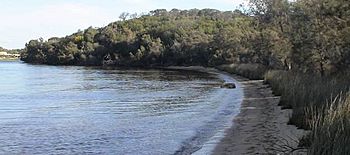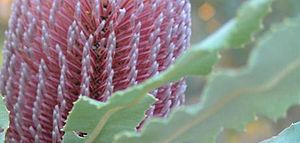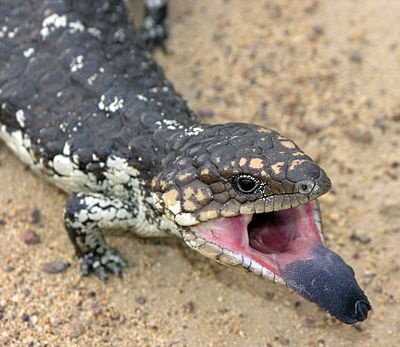Mount Henry Peninsula facts for kids
| Mount Henry Peninsula | |
|---|---|
| Location | Perth, Western Australia |
| Traditional land owners | Noongar |
| First title holders | Manning family |
| Size | 0.119 km2 (29 acres) |
| Land title | Privately owned |
| Current owners | Aquinas College, Perth |
Mount Henry Peninsula is a special piece of land and a nature reserve. It is located about 11 kilometers south of Perth, Western Australia. You can find it on the north side of the Canning River, close to the Mount Henry Bridge in Salter Point, Western Australia.
This peninsula covers about 11.9 hectares (which is like 30 football fields!). It has different types of natural areas. You'll find woodlands with Banksia attenuata and Banksia menziesii trees. There are also muddy areas and places that look like deserts. The peninsula has rocky limestone slopes, plants along the shoreline, and wetlands. It's home to many kinds of birds and other animals. Mount Henry Peninsula is so important that it's called a Bush Forever Site, number 227. This means it's protected forever.
The land is owned by the Congregation of Christian Brothers. It is part of the Aquinas College property. They manage it as a reserve to protect its history and nature. It's also used for education and quiet outdoor activities. Older students at Aquinas College help look after the environment here.
The "Canning River Wetlands," which includes Mount Henry Peninsula, is on Australia's national list of important natural and cultural places. This list is called the Register of the National Estate. The Christian Brothers have promised to protect Mount Henry Peninsula for the future. They did this by signing up for the Bush Forever program.
Contents
History of Mount Henry Peninsula
Traditional Owners and Early Uses
The Noongar people are the traditional owners of this land. They have lived here for a very long time. The Noongar people used Mount Henry as a lookout point. They could see smoke from family campfires from here. They also set up fish traps around the peninsula. They gathered food and used special burning methods to hunt animals. This method is called fire-stick farming.
Mount Henry got its name from Lieutenant John Henry. He was from a ship called HMS Challenger. In June 1829, he led a group of 25 men. They were the first to explore the Canning River and the Manning area.
Aquinas College and Conservation
In 1936, a Christian Brother named Paul Keaney bought 165 acres (about 0.67 square kilometers) from the Manning family. This land was at Mount Henry, along the Canning River. The Christian Brothers started Aquinas College in 1938. They kept the Mount Henry Peninsula bushland because they believed nature was a perfect setting for a Christian boys' college. They thought the natural beauty would help students think about "higher things."
Geology and Land Features
Mount Henry Peninsula is a noticeable piece of land. It has limestone rocks along the Canning River shoreline. It is one of the few places left along the river with its original natural environment.
Years ago, before people worried much about conservation, the slopes were damaged. The sandy soil and limestone hills often suffered from erosion. Some parts had even collapsed. At one time, people used the peninsula as a limestone quarry. Today, you cannot see any signs of this quarry from the river or the walking paths.
In late 1996, the Mount Henry Conservation Group (MHCG) started working on the peninsula. Jan King led this group. A big part of their work was making the eroded slopes stronger. Today, the Mount Henry Conservation Group still works to strengthen the slopes and stop erosion.
Flora: Plants of Mount Henry Peninsula
Native Plants
The native plants on Mount Henry Peninsula are very diverse. They change from reeds near the shore to larger banksia and tuart trees further inland.
The peninsula has open woodlands of tuart trees (Eucalyptus gomphocephala). These woodlands change into lower, open woodlands of marri (Corymbia calophylla), jarrah (Eucalyptus marginata), and the Western Australian Christmas tree (Nuytsia floribunda). The plants growing under these trees are very varied. Mount Henry Peninsula is the only remaining bushland on the Swan Coastal Plain that has foreshore plants, limestone slope plants, ridge woodlands, and wetland plants all in one place.
At the bottom of the hill, there is a small group of swamp cypress trees (Actinostrobus acuminatus). Along the riverbank, you will find different plants like Juncus kraussii, Scirpus nododsus, and Suaeda australis. Overall, the area supports over one hundred native plant species.
Banksia Species and Their Importance
Two types of Banksia plants grow on Mount Henry Peninsula. They are B. attenuata, also called candlestick banksia, and B. menziesii, or firewood banksia. The B. attenuata flowers from spring into summer. The B. menziesii flowers in autumn and winter. Because both types are here, at least one Banksia species is always flowering. This is very important for supporting the many birds on Mount Henry Peninsula.
Both Banksia species are sensitive to a plant disease called Phytophthora cinnamomi dieback. Because of this, special, less harmful weed killers are used on Mount Henry Peninsula.
Introduced Plants: Lachenalia reflexa
The Yellow Soldier Weed
The yellow soldier plant comes from South Africa. It is an introduced weed in the Mount Henry area. This yellow soldier species is very harmful to native plants and animals. It is so dangerous that it's on a national weed alert program. It is one of only 28 weeds in Australia recognized as extremely dangerous to natural bushland. This plant grows to about 10 centimeters when it flowers. It spreads easily through its seeds. Yellow soldier plants can also grow back from bulbs left in the ground after a fire or if the plant is not fully removed.
The best way to remove yellow soldier is by spraying herbicides on specific spots. Since it can quickly grow from seeds, it needs to be sprayed multiple times to get rid of it completely. The herbicide used was specially made by the Department of Agriculture and Food.
Fauna: Animals of Mount Henry Peninsula
The Mount Henry area of the Canning River is being restored. These areas are now safe places for native plants and animals. This includes 37 bird species and 11 reptile species. Some of the animals recorded here are:
- Bandicoot
- Legless lizard
- Dugite (a type of snake)
- Osprey (a type of bird)
- Bobtail lizard
- Raven
- Seagull
Reptiles on the Peninsula
Many different types of lizards live on the peninsula. The most common is the blue tongued lizard. There have also been sightings of legless lizards. Snakes usually move away from people, so there is little interaction with them. Very few dugite snakes are present on the peninsula. The Department of Conservation and Environment has been studying the lizard populations. They want to see if they can start a program to control introduced animal species.
Birds of the Peninsula
Other birds, like the honeyeater, are often seen in the bush. Crows are also present. Seagulls sometimes visit the school area but usually do not live on the peninsula itself. The most important birds on Mount Henry Peninsula are the osprey (Pandion haliaetus).
The osprey is a large bird that hunts fish in the area. It is often called a fish hawk. An osprey is about 60 centimeters long and has a wingspan of 135 to 180 centimeters. They build nests on dead trees, power poles, and floating buoys. Ospreys might only be here for a few weeks each year. They can catch up to two fish per hour, each 30 to 60 centimeters long. An osprey eats about 0.23 kilograms of fish per day. The osprey nesting on Mount Henry Peninsula now stays almost all year. Its nest is on a platform and post given by Western Power. This was after a fire went through the bushland in late 1997.
The osprey is a great example of how predators and prey interact on Mount Henry Peninsula. It is an "ecological specialist." This means it relies on specific types of food or habitats. The osprey mainly eats fish. Its special back claws help it grab fish when it dives. It is thought to be the only bird in the area that fully goes underwater when it dives. The osprey eats almost any fish it can catch. Fish found in the Mount Henry-Canning River area that ospreys eat include black bream, Swan River goby, and Perth herring.
Bandicoots: Small Mammals
There have been only a few sightings of the bandicoot on the peninsula. When they are seen, they are usually the long-nosed bandicoot. This type of bandicoot is found all over Australia.
Records show that bandicoots have been on the peninsula since the first Europeans arrived. At one point, the number of bandicoots went down. This was because rabbits were brought into the area. The Mount Henry Conservation Group has removed all rabbits from the area. Now, there are records of bandicoots returning to the peninsula.
Community Service Program
The Community Service Program at Aquinas College helps students learn about bush regeneration. This is often a new idea for many students. Through this program, they learn how important bushland is and how they can help protect it. The group includes local community members, staff, parents, and students.
Peninsula Projects and Achievements
The Conservation Group has completed many important projects. They have received grants and worked with partners. Some of these projects include:
- Creating information boards for the shoreline and bushland. This was paid for by the National Estate Grants Programme.
- Fixing and replanting badly eroded parts of the steep limestone slopes.
- Planting heavy jarrah trees for terracing.
- Fixing a slope near Mount Henry Bridge that was damaged by people climbing on it. They created paths, and junior school children planted trees. Fences were also repaired.
- After a large bush fire, Western Power, Park Engineers, and CALM staff put up an osprey nesting platform. This replaced a fallen tuart tree where an osprey pair had been nesting.
- Contractors were hired to spray the burnt area to remove Veld grass. People also helped by removing weeds by hand.
- The City of South Perth has placed traps to try and get rid of rabbits.
- The MAMSJH Foundation, started in 1990, works to restore plants and improve the flora on the peninsula. They are known for "Bank-sir for Banksia Day" on July 12 each year.
Funding for Conservation
Keeping the Mount Henry Bushland area healthy is very expensive. This is mainly because it is so large. Money and grants from charitable organizations, corporations, and the government are very important. They help continue the work of looking after this environment. The following groups and organizations have helped fund and maintain the area:
- City of South Perth
- Swan River Trust
- Western Power Corporation
- Department of Environment and Conservation
- Alcoa
- Alinta Gas
- Western Australian Government
Images for kids





